Purees + BLW with SLP Feeding Expert Dawn Winkelmann
In this episode, Dawn Winkelmann, MS, CCC-SLP joined me to talk about how to safely incorporate purees in the early stages of baby-led weaning. We covered:
- Why purees are an important texture for your baby to master...but they’re certainly not the ONLY texture your baby should get stuck on!
- How to teach your baby to self-feed with a pre-loaded spoon...so you can honor the principles of baby-led weaning by allowing baby to regulate his or her intake
- Why you want to use an appropriate sized baby-led weaning spoon...and Dawn shares the background behind why she designed the Tiny Spoon the way she did for ezpz

LISTEN TO THIS EPISODE
Episode Description
Purees are an important texture for your baby to master...but they’re not the ONLY texture your baby can eat. In this bonus episode feeding expert Dawn Winkelmann, MS, CCC-SLP explains how you can honor the principles of baby-led weaning and promote independent eating while also incorporating purees for your baby.
Dawn specializes in pediatric swallowing and is the feeding expert and a product designer for ezpz. She encourages self-feeding by spoon using a pre-loaded spoon technique and she explains how to do so safely in this episode.
You can incorporate purees for your baby along with other traditional baby-led weaning soft solid foods. Dawn also provides tips on switching from purees and talks about important feeding milestones you can help your baby achieve with baby-led weaning.
About the Guest
- Dawn Winkelmann, MS, CCC-SLP is a speech language pathologist specializing in pediatric swallowing
- She is the award-winning product designer for ezpz and created the Tiny Cup and Tiny Spoons for baby-led weaning
- Dawn is passionate about helping babies start solid foods safely
Links from this Episode
- Check out Dawn Winkelmann, MS, CCC-SLP - better known as @msdawnslp on her website here
- Here is a link to the Tiny Spoon from ezpz that Dawn designed & discusses in the episode, get 10% off with code KATIE10 (this is for babies 6-12 months)
- Once your baby sizes out of the Tiny Spoon, check out the Mini Utensils (fork + spoon set) also designed by Dawn, these are for 12 months+ and 10% code is KATIE10
- Baby-Led Weaning with Katie Ferraro program with the 100 First Foods™ Daily Meal Plan, join here: https://babyledweaning.co/program
- Baby-Led Weaning for Beginners free online workshop with 100 First Foods™ list to all attendees, register here: https://babyledweaning.co/baby-led-weaning-for-beginners

Latest Episodes
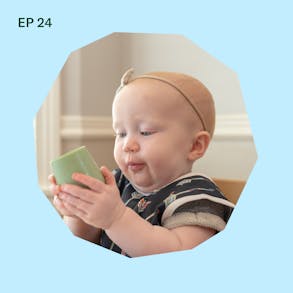
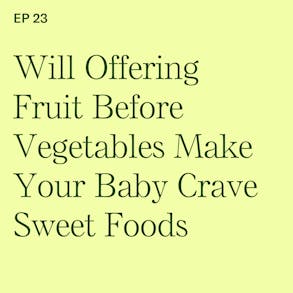
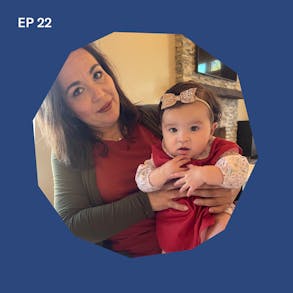
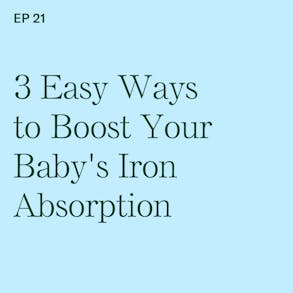
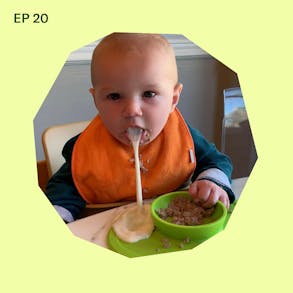
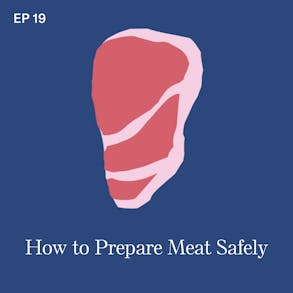
Dawn Winkelmann (0s):
We want to introduce spoons as soon as we're introducing solids, because as you allow your baby to have the spoon you're promoting that independence, allowing the sensory development of exploring that new utensil and being able to have that relationship with meals.
Katie Ferraro (16s):
Hey there, I'm Katie Ferraro, Registered Dietitian, college nutrition professor, and mama of seven specializing in baby-led weaning. Here on the Baby-Led Weaning Made Easy Podcast I help you strip out all of the noise and nonsense about feeding, leaving you with the competence and knowledge you need to give your baby a safe start to solid foods using baby-led weaning.
Dawn Winkelmann (43s):
Well, hello. Welcome back to another episode of the Baby-Led Weaning Made Easy Podcast. You guys, I am so excited about today's episode. It's my good friend and colleague Ms. Dawn Winklemann. And you guys might know her on social media. She's miss Dawn SLP, but she's a speech language pathologist. She specializes in baby-led weaning and pediatric swallowing. And I've had the good fortune to work with her now for a number of years developing courses and programs and doing talks and teaching about baby-led weaning because as a dietitian, my specialty is in what foods your baby can and should be eating from a nutrition and growth standpoint. But Dawn really specializes in the mechanics of how your baby learns how to eat and how to swallow food safely.
Katie Ferraro (1m 27s):
So she's very unique as a speech language pathologist in that she's put together a number of different programs, and she's also a product designer. She's going to talk a little bit about the baby-led weaning spoon that she designed and how that helps facilitate self-feeding. So I think you guys are going to love this episode because we're diving into a topic that some parents are confused by, which is how can you incorporate purees and have success with baby-led weaning. And it's not what you would think, because we typically think of purees is like traditional spoon-feeding right? Where the parent pushes the spoon into the baby's mouth. That's not what we're talking about here. Dawn is going to show you how you can help your baby self feed. So you can use purees help your baby swallow safely, especially when you're just starting out with baby-led weaning.
Katie Ferraro (2m 9s):
So I hope you like this episode and hang tight till the end, because I'm going to tell you about a series of free workshops that Dawn and I are teaching together online. If you like the baby-led weaning for beginner stuff, we're going to kind of help you get to that next phase of how you can help really push your baby's palate and have success with baby-led weaning. Once you get past the puree phase. All right. Here's Dawn. All right. Well, welcome back to another episode of the baby-led weaning podcast. I've got Dawn Winkelmann with me today. Hello, miss Dawn.
Dawn Winkelmann (2m 39s):
Hi Katie. Thank you so much for having me on your show.
Katie Ferraro (2m 41s):
Well, thank you so much for being here. I know you are an insanely busy person. I have the good fortune of working with you on a fair number of projects, but this is your first time on the podcast. And it's because you are only the second guest ever.
Dawn Winkelmann (2m 54s):
Woo I'm winning. Awesome. Getting it at the ground level.
Katie Ferraro (2m 57s):
Thank you so much for being here. You guys, Dawn a speech language pathologist who specializes in pediatric swallowing. She is also a product designer. She's going to tell you a little bit about that, but she specializes in baby-led weaning, which is the primary reason why she's here today. Because as a dietitian, my area is all about what you feed your baby and why we do it from a nutrition and growth standpoint. But I love working with Dawn because as a feeding therapist, trained in infant feeding specializing in pediatric swallowing, she's really the one who can help you with the mechanics of how your baby learns how to eat and in particular, how your baby learns to swallow food safely. So we are going to be talking today about purees, which you might be surprised to hear about on a baby-led weaning podcast.
Katie Ferraro (3m 42s):
But miss Dawn is going to blow your mind in that regard. We're here today to talk about purees and baby-led weaning and Dawn, if it's okay, I'd love to dive right into the first question, which is, tell us why it is important for babies to learn how to master purees.
Dawn Winkelmann (3m 57s):
Thanks, Katie. I really like my families that I work with and the community that we serve to be able to talk to them about swallowing. You know, one of the things that parents often ask us is, you know, they're fearful of choking and how they can kind of reduce their risk. So what I like to teach parents is that in the beginning I use purees to make sure baby swallow is safe, but the focus on purees is a very short window of time. As we're assessing that swallow, it usually takes about a week as you're offering these tiny tastes, but we're really focusing on how baby is triggering that swallow. What's great about this is that when we are looking and we're offering baby these tiny tastes of purees, we just want to make sure that baby is not showing some signs and symptoms of what we call aspiration and that's food or liquids going down into the lungs.
Dawn Winkelmann (4m 48s):
And it's much easier to be able to see if there's a, you know, rare, but difficulty swallowing with a puree as compared to a big piece of a chicken leg. So I like to be able to just, you know, teach our families, to be able to try purees, to be able to look at that swallow and then be able to jump right into baby-led weaning.
Katie Ferraro (5m 10s):
And I think what you said there is so important. As I mentioned, I've worked with you now for a long time. So I feel like a lot of our messages overlap and it's like, I can't remember who said it first, but I love when you mentioned that you only need to do purees for a week. I usually tell parents, you know, purees for a few days, parents are like, what? It's not weeks and months on end that your baby needs to be stuck on purees, but you guys, I hope you're hearing what Dawn's saying is that purees are still an important texture to master. Because as you know, your baby's only ever had formula or breast milk for the first six months of life very quickly, we can progress them to the soft, solid textures that are consistent with traditional baby-led weaning, but there's that little bridge for a few days. And that's where purees come important.
Katie Ferraro (5m 52s):
So, Dawn, I think maybe people listening to the podcast are like a little bit perplexed because when they think of baby-led weaning think, oh, that means completely bypassing the puree phase. So in your approach to starting solid foods, you incorporate purees. How then can we uphold the principles and the philosophy of self-feeding, which are integral to baby-led weaning If we're also doing purees.
Dawn Winkelmann (6m 16s):
This is, this is really complex in the sense of, you know, choosing one method or another. But really what we're focusing on is giving baby control, which is the basis of baby-led weaning. We want to give baby control. We're not spoonfeeding baby. And when we're doing the, you know, the purees there at the beginning, we're not spoonfeeding them either. That's why sometimes it can take a few days because baby is actually putting that spoon into their mouth. We are not controlling what baby is doing, because basically when you are spoonfeeding and you're shoving those foods into your baby's mouth for the very first time, it can be very overwhelming.
Dawn Winkelmann (6m 58s):
And a lot of babies have a lot of negative reactions to that type of feeding method. So letting your baby have control of whether they put an avocado slice in their mouth, or they're putting the spoon in their mouth, that is really the essential part of using purees. You know, at the very beginning to assess the swallow, but still allowing baby to be in control of that. And then the second thing with the principles is giving baby the food that the entire family's enjoying. So if you're, you know, eating some yogurt, you're offering baby yogurt, that's a puree. If you're eating some carnitas and some nice soft meat, you're offering that to your baby, the principles are still there.
Dawn Winkelmann (7m 40s):
The big thing with offering those purees is that we are assessing that swallow. Of course, I see all the babies that have difficulty swallowing or have, you know, had choking episodes because they, you know, have been fed by a spoon and sometimes forcefully, you know, if I was going to feed you, Katie and I was going to spoonfeed you, you even know you are a master eater, I'm a master feeder. I, I would, I would put maybe more food on the spoon that you were used to, or I might put the spoon in too far and actually elicit a gag response from you. I could turn it over or put too much pressure on your tongue or graze your teeth or hit your lip.
Dawn Winkelmann (8m 23s):
All of those things really can make starting solids a negative experience for baby. So the principles of baby-led weaning is giving baby control, allowing baby to decide how much they're going to eat. We are offering the foods to baby and whether those are, you know, purees there at the beginning or purees throughout the, the entire process, you know, there are foods that melt and we can use those as dippers. We want to practice intuitive eating, and those are the fundamentals here. We want to allow baby to be able to eat as much as they want and not to over eat.
Katie Ferraro (9m 4s):
You guys, you know, remember it's not your job to determine how much or even whether your baby eats, right, that's your baby's job. And to kind of tie into what Dawn was saying, some of the drawbacks of traditional spoonfeeding whereby the parent or caregiver puts the spoon directly in the baby's mouth, which as Dawn mentioned, putting any foreign object in a baby's mouth, including a spoon can increase choking risk. She mentioned all of the sensory reasons in this with speech and swallow related reasons why you wouldn't want to do that. But from a nutrition standpoint, I always like to add that you are then arbitrarily picking the portion size that you think your baby should be eating when you decide, okay, this three ounce jar or this 2.7 ounce pouch is how much I've decided you're going to eat that flies in the face of baby-led weaning because the baby's not in control.
Katie Ferraro (9m 47s):
So with this self feeding approach that Dawn's talked about, the baby's allowed to feed themselves. And Dawn, I think this is again news to a lot of people. So could you maybe just describe how this, the preloaded spoon technique works so that we can incorporate the principles of baby-led weaning while allowing our baby to master the important texture that is you're right.
Dawn Winkelmann (10m 8s):
Yes. Pre-loading a spoon is essential because basically when you're starting solids at six months of age, your baby does not know how to feed themselves. So they're going to learn that process. That's why baby-led feeding is so fun and a little messy is because baby is learning, right? So we want to set up baby for success. So we want to offer a pre-loaded spoon that you're putting some of those purees on, or a little bit of avocado or a squished blueberry. And we want that to be on the spoon and having that handle facing them so they can grab it really easily. And so then baby, all baby has to do is just bring it to their mouth really easily. Instead of having to learn how to dip, which developmentally comes later or learning how to scoop, which again, developmentally comes later, we want to be able to set baby up for success with that preloaded spoon.
Dawn Winkelmann (10m 57s):
So they're just having to actually get that food to their mouth, which is what they're doing around six months. Anyways, they're bringing objects to their mouth. And so they can be really successful with that. As long as we set it up to make it accessible to them.
Katie Ferraro (11m 11s):
Can you talk a little bit about the spoon, because I mentioned at the top of the podcast that you are a product designer, I personally use the recommend the baby-led weaning spoon that you designed. But when I started baby-led weaning, for example, with my quadruplets who are now four years old, there wasn't a baby-led weaning spoon out there. And so implementing this whole approach of trying to encourage the baby to self feed with a spoon when there wasn't a spoon appropriate for a baby was a real challenge as a parent. And you kind of tackle that challenge with your own product. If you could maybe tell us a little bit about that from the spoon standpoint.
Dawn Winkelmann (11m 43s):
Yes. Thanks. I designed a product called the tiny spoon and it's by ezpz. And I designed that product for ezpz specifically as a baby-led because there's two things that we really want parents to be able to feel really successful using this approach and being a confident feeder. And that is to be able to allow your child to have an object i.e. a spoon, that they can learn how to be able to do all these milestones. You know, milestones are set there for us to kind of know what to expect, but babies are very different. I wanted to have a spoon that could allow baby to dip.
Dawn Winkelmann (12m 25s):
If baby is learning to dip a little bit earlier, I wanted a spoon that allows baby to scoop. If baby develops that skill a little bit earlier, traditionally with baby-led weaning, we're not offering a spoon and why I wanted to design a baby-led spoon is because I was seeing these kids that were doing a very strict baby-led weaning approach, not making their feeding milestones, which again, is being able to use utensils, being able to bring that spoon to their mouth. And so as a feeding therapist, I was seeing like these kids are so skilled in so many different ways using a baby letter approach, they have a whole bunch of different foods under their belt, but they're really not able to utilize utensils as other babies are.
Dawn Winkelmann (13m 8s):
So I wanted to have a spoon that could address all of these things, dipping, scooping, developmental milestones, and actually also stimulate the mouth to be able to ease those sore gums during this process. You know, we think of feeding as, okay, you know, baby's intuitively going to grab this food and be able to just run with it. And really this is a whole learning process. So we need to have a spoon that is soft and safe in the mouth. So a lot of spoons out there are made out of hard plastic or metal, and that can really disrupt the baby's gums and disrupt their feeding because when they're shoving a spoon in their mouth, that they're just learning how to, how to do that.
Dawn Winkelmann (13m 49s):
And it hits that sore gum or hits that new tooth. It can really develop food versions. So I designed a spoon that's made out of a hundred percent food grade silicone, it's called again, the ezpz tiny spoon. It has sensory bumps on the spoon bowl itself to be able to give baby that sensory cue, not to put the spoon in too far, which will decrease gagging. A lot of spoons out there have a really deep spoonful. So babies have to suckle that puree off, which can cause choking because we're having to suck that in and it can, it can actually cause a baby to gag and choke. So the sensory bumps on the spoon and it's a flatter, bold spoon.
Dawn Winkelmann (14m 32s):
It makes it really easy for babies to be able to use their lips, use her tongue properly, which again is these motor movements babies are supposed to be doing during this time. And then I also designed it to be a short, fat round handle. And why that is, is that the research shows us that's the best way for babies to be able to grab on and be able to facilitate these hand to mouth movements, just like they would with an avocado slice. We want them to be able to use the same motor movements that they will with traditional baby-led weaning, grabbing that food and putting into their mouth and make it functional for them to again, be able to use a spoon if they choose to do so.
Katie Ferraro (15m 12s):
Okay. Awesome. And then the tiny spoon that Dawn developed you guys again, she's the feeding expert for the company ezpz who makes a wide array of feeding gear, many of the pieces of which Dawn has had a hand in either designing, redesigning the tiny spoon she actually designed from scratch. It comes in a two pack. So if Dawn, maybe you could just share with us why the tiny spoon comes in a two-pack
Dawn Winkelmann (15m 34s):
Yes, for two reasons. Number one is that as we are doing a baby-led approach, you are pre-loading that spoon, you are offering that spoon on, you know, on the edge of the bowl or to a plate. So that baby can actually pick that spoon up really easily. And then you want to have that next spoon ready. So when baby drops the spoon, the second spoon is already there and available. So that's one reason. The second reason is that we don't offer a fork during this time when babies are first learning to eat. Again, those motor movements to the mouth are, are in practice mode. They have not perfected this, and we're not expecting babies to be able to perfect this. We are not expecting babies to actually be able to Pierce and use a fork until much later down the road.
Dawn Winkelmann (16m 20s):
So I didn't want parents to feel like they were unsuccessful. I get lots of calls from families wanting their baby to be in feeding therapy because they started solids at six months of age, they implemented a fork and baby's not able to do it. And I have to calm these parents down because they're feeling like they're failing at feeding. And we have so much pressure to be able to feed kids in general that they don't need to feel like they're feeling the first couple of weeks of starting solids. And I tell these families, your baby developmentally is not even supposed to be using a fork. So don't even offer a fork. You know, we don't want to set babies up for not making these feeding milestones.
Dawn Winkelmann (16m 60s):
We want to set them up for success and offering a fork at six months is not only dangerous for them, but it's not developmentally appropriate. So using a spoon is really the skill that we want to be able to develop. And we want them to be successful with bringing that spoon to the mouth and then be able to implement a fork later on when it's posed to be developmentally appropriate. So it's a two pack of two spoons instead of a spoon and a fork.
Katie Ferraro (17m 25s):
You guys just so you're aware Dawn has two different types of spoons that she's developed for ezpz. And I've just seen among my audience, a little bit of confusion because the tiny spoon is designed for babies aged six months to 12 months. And so that's the spoon that you want to start with. It's the handle is silicone. The bowl of the spoon is silicone. It has the sensory bumps. The bowl is very appropriately sized for your early eaters mouth. Now, as your baby gets a little bit, they will actually kind of size out of the tiny spoon. So starting at around 12 months of age, I know personally with my twins, Gus and Hannah, they started solids thankfully, right? When you created the tiny spoon Dawn. So we actually got to be your Guinea pigs at the beginning, which was so fun to test that spoon out.
Katie Ferraro (18m 6s):
But by the time they were about 13 or 14 months of age, they were getting frustrated with the small size of the spoon and voila. At about that time you created and designed the mini utensils for ezpz and those are for babies aged 12 months and older and Dawn. I know we both are now kind of seeing this trend of parents, unfortunately buying the mini utensils for earlier babies. So could you maybe describe real briefly why we want to use the right spoon at the right time?
Dawn Winkelmann (18m 31s):
Yes, I designed these spoons specifically regarding tongue size, mouth sized jaw size, the mouth of a six month old baby is very different from the mouth of a 12 or 13 month old toddler. So we want to be able to decrease the risks of gagging and choking by the size of utensils that we're using. So if a parent is using a mini utensil, which is again, designed for toddlers for a six month old baby, that spoon is going to be ginormous in their mouth. And then what baby has to do is circle again, that food off, which can, you know, illicit a gag or choke because we want baby to actually use her lips, but the spoon would be too big.
Dawn Winkelmann (19m 18s):
And again, you know, other spoons that are out there, this is why, you know, a lot of the babies that I work with have so many negative experiences with spoons and then end up having these food refusals and parents are like, what's going on? I thought that I was doing all the right things. And you know, you would think that there's more research and design out there when you're looking, you know, down the aisles to be able to, you know, buy and purchase feeding products for your kids. But really that's not what occurs. So the design of the tiny spoon is for six month old to 12 month old. And the design of the mini utensils are for 12 months. Plus now that two pack, so it's a spoon and a fork because we actually want toddlers to be using a fork.
Dawn Winkelmann (20m 3s):
We're expecting that from a developmental standpoint, we're expecting them to want to be able to participate in that we're expecting their wrist movements and different, fine motor skills to be perfected by then. So now it's safe to be able to offer a fork. And again, we're encouraging parents like, Hey, this is the next milestone. Mom, daddy did a great job offering that spoon to baby. When they were six months to 12 months, you've been utilizing that during meals and you're actually making your baby be ready for this next huge skillset of using a fork.
Katie Ferraro (20m 36s):
Exactly. And they don't have to be incredibly proficient right at their 12 month mark you guys. But again, hopefully you're hearing with Dawn saying is that your baby prior to 12 months of age does not need to use a fork. So don't stress yourself out with an step stick to the tiny spoon from the time your baby is six to 12 months of age. And when you're starting out, don't be scared to do purees, but don't be scared and only get stuck on purees because as many of you know, Dawn and I teach a program together called the 100 first foods field guide, where we work with parents to help them introduce their baby to a hundred baby-led weaning foods, but to do so safely. And we teach this purees for a few days approach whereby we show you and Dawn shows you how to make a thin puree, a thicker puree, and then soft, solid strips of food.
Katie Ferraro (21m 21s):
But again, we only do that for a few days. You don't need to unnecessarily puree foods that your baby could eat soft, solid versions of the intact version of that food after about the first week. And we see some parents, unfortunately, who gets stuck on doing purees for weeks and months on end. And there's no way their baby's going to get the variety that they need to become an independent eater and prevent picky eating. So if you kind of think back to why you even got interested in baby-led weaning for the very first time, it's probably because you heard baby-led weaning and there's research to support. This helps you raise an independent eater and helps prevent picky eating. You do need to do some periods along the way. I know my own mom. I remember when my quadruplets were doing baby-led weaning.
Katie Ferraro (22m 2s):
She's a dietitian as well, but she said, I think this whole baby-led weaning thing is ridiculous. I mean, eating with your hands is fine, but like at some point they're going to have to learn how to eat yogurt off of a spoon. What about apple sauce? What about oatmeal? It's like mom. You're right. So you guys, we do use the naturally pureed forms of foods for our babies to learn how to eat. And Dawn's tiny spoon is a great tool to help your baby make that possible because yeah, they will try to eat some of these foods with their hands. But we do want to put that spoon out there at about six months of age of Dawn. I got a question the other day that I've never gotten before someone in my membership group asked, is there a milestone for how many times a week you should offer the spoon? Cause I offer mostly foods that don't need a spoon and now I'm worried my baby's not getting enough practice.
Dawn Winkelmann (22m 44s):
And I was like, I got to ask on this one. I'm not aware of one, but we want to introduce spoons as soon as we're introducing solids. So I tell families that even if your baby at first doesn't even use the spoon. So let's say you are, pre-loading that spoon and you're putting it there for baby. And baby just has no interest. It's fine. They need to be able to be exposed to that. Just how we talk about Katie, how you know, these babies have to be exposed to all these different colors and textures and tastes. It's the same thing with putting out that utensil baby will begin to use that utensil more often when they are ready. But if we don't give baby the opportunities, we're not going to be able to ever see if they're able to utilize those fine motor skills and make that more successful.
Dawn Winkelmann (23m 27s):
And as we're offering those solid foods and baby is getting more and more proficient with the solid foods, you're going to see them starting to grab that spoon and try it to make that dipping skill, to scoop and be able to utilize that spoon more often. And sometimes at the very beginning, they might just use the tiny spoon to actually just put in there and just kind of Mount that for a little bit. All of those are practice and teachable moments and really important to be able to promote independence because as you allow your baby to have the spoon, even if you're offering it every single day, but really they're only using it once a week, you're promoting that independence, allowing the sensory development of exploring that new utensil and being able to have that relationship with meals.
Dawn Winkelmann (24m 13s):
And if you're eating with baby too, she's watching you put the spoon into your mouth. So they're going to start to model that behavior and be able to really utilize that spoon as another way to be able to ingest solids again at their school.
Katie Ferraro (24m 29s):
Yeah. And it's another use of that second tiny spoon is mom or dad or caregiver can be, you know, you guys demonstrate how you bring the spoon to your mouth and eat food. And your baby's really watching what you're doing through this whole exploratory period and Dawn that's one of the reasons why I love working with you because I feel like as a speech language pathologist, you really get the importance of the whole learning, how to eat developmental phase, which I know not all speech language pathologists, much like not all registered dietitians are on board with baby-led weaning, but I really love your common sense approach. That's also coupled with the research, plus your background in feeding therapy to say, you know, babies can learn how to self feed, but they also need to learn how to master puree.
Katie Ferraro (25m 8s):
So I just want to say thank you for that. And just wondering for, we have a lot of speech language pathologists in our audience who maybe aren't super pro baby-led weaning. And I think it's important for them to see a feeding expert such as yourself really embracing this approach to starting solid foods, but doing so safely. Would you mind chatting about that for just a minute?
Dawn Winkelmann (25m 30s):
Yeah, absolutely. Traditionally there's not a lot of speech pathologists who really embrace this approach. And the reason why I started actually embracing this approach is because the parents really wanted to learn how to do this. And I was seeing an influx in my private practice of these babies. That again, you know, weren't making their feeding milestones. When it came to using utensils, they were really struggling with a variety of textures and parents were having these, you know, choking episodes. And so I kept saying to my colleagues, like, I'm going to be teach these families how to do this safely. I'm going to teach these families how to do this, utilizing the developmental milestones that we all know and be able to allow them to utilize the screen correctly, allow them to be able to learn how to make food safe and allow these babies to actually make these feeding milestones.
Dawn Winkelmann (26m 30s):
What is, what is surprising is the number of speech pathologists that are actually starting to come on board because you know us as a profession, we're waiting for like evidence-based research, we're waiting for us to kind of observe these things. And when I first started, it was basically clinical observation. I was seeing that these babies that were starting with solid foods and being able to feed themselves were making ginormous gains and other areas. And so it was just being able to have a balance of using, you know, what we know is developmental and feeding research and blending that approach to be able to let babies be successful, but not just babies parents too.
Dawn Winkelmann (27m 10s):
They feel more successful when they are offering foods that are culturally appropriate for them. And they're not feeling like, you know, I'm wanting to offer my baby a certain culture of food, but I'm feeling like I have to actually offer food from a pouch. It is allowing the whole family unit to lead feeding in the way that makes them feel comfortable. And I think it just takes some professions a little bit longer than others to kind of get behind that when we've been, you know, in such a very traditional approach of, of, you know, using purees for long periods of time. That's why the research that you're talking about is so important because we know that if babies get stuck on purees, they tend to be picky.
Dawn Winkelmann (27m 53s):
So we want our babies to have a variety of tastes and textures and flavor profiles that are important to be able to develop the mouth and be able to allow babies to move their tongue around more in their mouth, to be able to really have a good mouth development like a good palette.
Katie Ferraro (28m 13s):
Absolutely. And also from a nutrition standpoint, needing to be able to get all the different foods that have the different nutrients trial, the different allergenic foods, it requires expanding your palate. And you mentioned the research like both of us, thankfully, are from professions that value the importance of evidence-based research. And I think it's important for parents to know that there is this real, incredible body of emerging literature that shows us that babies who start solids with baby-led weaning are at no higher risk of choking than our babies who are traditionally spoon-fed provided that the parents are educated about reducing choking risks. And that's the caveat there it's that education stuff. So you guys listening to podcasts or watching videos or attending seminars by feeding experts like Dawn and taking courses.
Katie Ferraro (28m 58s):
These are ways that you learn how to reduce choking risks so that your baby can then recognize the benefits of baby-led weaning. And so for those of you who are interested in learning more Dawn and I are actually going to be teaching a series of live workshops together online, starting right now, the, the day that this podcast goes live, we have a free online workshop called what do I feed my baby after avocado banana and sweet potato? So we know that you guys sometimes are get gung ho starting out, baby-led weaning. I did some puree of avocado, a little bit softer strips of avocado, some bananas, some sweet potato, and then help. What do I feed my baby after that? So I can push them eventually into the combination foods and those trickier textures, the more complex flavors, all of the allergenic foods.
Katie Ferraro (29m 44s):
So we would love if you could join us on our free online workshops, there's a number of them. If you want to sign up, you can just go to the show notes page for this podcast. So if you go to blwpodcast.com, this is the second bonus episode, but it's slash bonus slash purees. But if you just search Dawn's name, it will pop up and there'll be a link there for you to register for our free workshop. We host a huge Q and A at the end. We like literally, I think the reason we're friends in real life as we both can't stop talking, we love talking about baby-led weaning, and we hope that you will join us on that workshop. Dawn, thank you so much for talking to us today about purees and baby-led weaning.
Katie Ferraro (30m 24s):
And you guys, if you want to hear more about what you do after the purees come to the workshop, what do I feed my baby after avocado banana and sweet potato. Thank you so much for being here, Dawn.
Dawn Winkelmann (30m 35s):
Thank you for having me and see you guys on that free online work show.
Katie Ferraro (30m 38s):
Bye now!
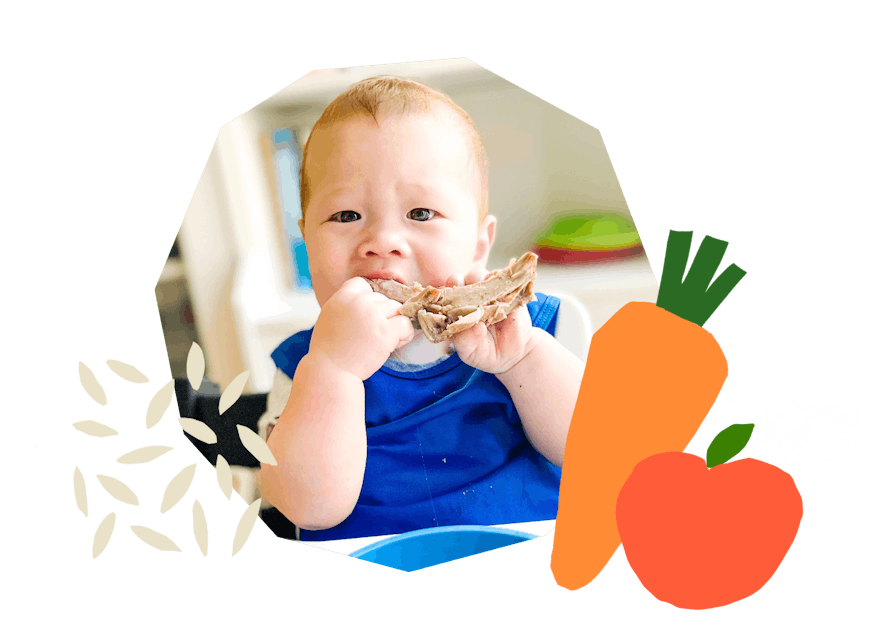
The Program Baby-Led Weaning with Katie Ferraro
A step-by-step digital program for starting solid foods safely and navigating the original 100 FIRST FOODS™ meal plan with baby-led weaning.
 EXPERT-LED, PROVEN APPROACH TO EATING REAL FOOD
EXPERT-LED, PROVEN APPROACH TO EATING REAL FOOD CONCISE VIDEO TRAININGS TO MASTER BABY-LED WEANING
CONCISE VIDEO TRAININGS TO MASTER BABY-LED WEANING 100 FIRST FOODS DAILY MEAL PLAN WITH FOOD PREP VIDEOS
100 FIRST FOODS DAILY MEAL PLAN WITH FOOD PREP VIDEOS
Baby-Led Weaning for Beginners Free Workshop
Is your baby ready to start solid foods, but you’re not sure what to do? Register for this free online video workshop and learn how to give your baby a safe start to solid foods using baby-led weaning. Everyone on this free training receives a copy of Katie’s original 100 FIRST FOODS™ list. You can take this workshop right now, later today when your baby naps, or tomorrow…whatever works for you!
Get baby-led weaning recipes and tips delivered to your email inbox.